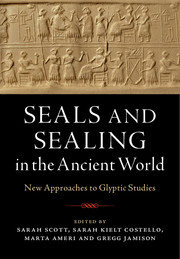 Seals and Sealing in the Ancient World
Seals and Sealing in the Ancient World Book contents
- Seals and Sealing in the Ancient World
- Seals and Sealing in the Ancient World
- Copyright page
- Contents
- Notes on Contributors
- Illustrations
- Plates
- Tables
- Acknowledgments
- Preface
- Abbreviations
- Chapter One Introduction: Small Windows, Wide Views
- Part I The Ancient Near East and Cyprus
- Chapter Two Administrative Role of Seal Imagery in the Early Bronze Age: Mesopotamian and Iranian Traders on the Plateau
- Chapter Three Slave Labor: Uruk Cylinder-Seal Imagery and Early Writing
- Chapter Four The First Female Bureaucrats: Gender and Glyptic in Third-Millennium Northern Mesopotamia
- Chapter Five Rematerializing the Early Dynastic Banquet Seal
- Chapter Six Sealing Practices in the Akkadian Period
- Chapter Seven Authenticity, Seal Recarving, and Authority in the Ancient Near East and Eastern Mediterranean
- Part II South Asia and the Gulf Region
- Part III Egypt
- Part IV Aegean
- References
- Endnotes
- Index
Chapter Six - Sealing Practices in the Akkadian Period
from Part I - The Ancient Near East and Cyprus
Published online by Cambridge University Press: 24 April 2018
- Seals and Sealing in the Ancient World
- Seals and Sealing in the Ancient World
- Copyright page
- Contents
- Notes on Contributors
- Illustrations
- Plates
- Tables
- Acknowledgments
- Preface
- Abbreviations
- Chapter One Introduction: Small Windows, Wide Views
- Part I The Ancient Near East and Cyprus
- Chapter Two Administrative Role of Seal Imagery in the Early Bronze Age: Mesopotamian and Iranian Traders on the Plateau
- Chapter Three Slave Labor: Uruk Cylinder-Seal Imagery and Early Writing
- Chapter Four The First Female Bureaucrats: Gender and Glyptic in Third-Millennium Northern Mesopotamia
- Chapter Five Rematerializing the Early Dynastic Banquet Seal
- Chapter Six Sealing Practices in the Akkadian Period
- Chapter Seven Authenticity, Seal Recarving, and Authority in the Ancient Near East and Eastern Mediterranean
- Part II South Asia and the Gulf Region
- Part III Egypt
- Part IV Aegean
- References
- Endnotes
- Index
Summary
During the Akkadian period in Mesopotamia (ca. 2334–2154 BCE) cylinder seals functioned within the highly developed administration established by the ruling dynasty in order to manage the state. Reconstructions of the economic management and organization of the state provide a useful context in which to examine glyptic art and in particular the relationship between imagery and sealing practice. This chapter explores the idea that different types of sealings may have had different functions within the administrative structure, and therefore would require varied kinds of information, or a different organization of the same information, to be conveyed via the seal impressed on the sealing. Innovations in sealing function at this time are considered in relation to two popular glyptic subjects, the contest and presentation scene, and how this imagery may express power and authority. The study of sealing types and practice in the Akkadian period can expand the discussion of the glyptic of this period beyond a focus on the innovative imagery and fine craftsmanship, allowing for new understandings of the ways in which certain glyptic imagery participated in systems of visual communication.
- Type
- Chapter
- Information
- Seals and Sealing in the Ancient WorldCase Studies from the Near East, Egypt, the Aegean, and South Asia, pp. 81 - 94Publisher: Cambridge University PressPrint publication year: 2018


